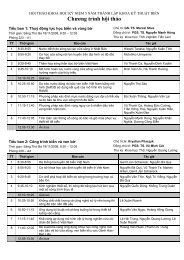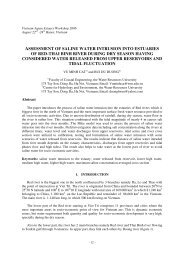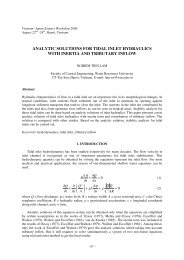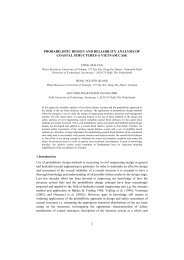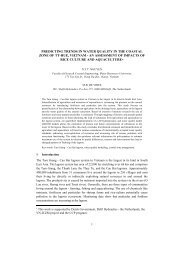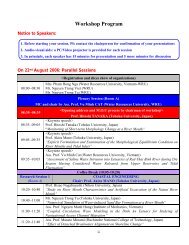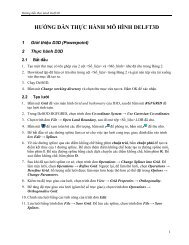salinity intrusion trend in river and canal systems and some ...
salinity intrusion trend in river and canal systems and some ...
salinity intrusion trend in river and canal systems and some ...
You also want an ePaper? Increase the reach of your titles
YUMPU automatically turns print PDFs into web optimized ePapers that Google loves.
Vietnam-Japan Estuary Workshop 2006<br />
August 22 nd -24 th , Hanoi, Vietnam<br />
SALINITY INTRUSION TREND IN RIVER AND CANAL SYSTEMS<br />
AND SOME PREVENTION METHODS IN BEN TRE PROVINCE<br />
Abstract<br />
TRAN THI XUAN MY 1 AND NGUYEN DINH VUONG 2<br />
1) Southern Institute of water Resources Research<br />
2A Nguyen Bieu street, District N o 5, Ho Chi M<strong>in</strong>h city, VietNam<br />
daotao-siwrr@hcm.vnn.vn<br />
2) Southern Institute of water Resources Research<br />
2A Nguyen Bieu street, District N o 5, Ho Chi M<strong>in</strong>h city, VietNam<br />
daotao-siwrr@hcm.vnn.vn<br />
Ben Tre prov<strong>in</strong>ce locat<strong>in</strong>g <strong>in</strong> the Mekong delta has been affected ma<strong>in</strong>ly by tide of the East Sea;<br />
sal<strong>in</strong>e water resources have <strong>in</strong>truded through 3 <strong>river</strong> mouths: Dai , Ham Luong <strong>and</strong> Co Chien. Due to<br />
the small quantity of flow, <strong>sal<strong>in</strong>ity</strong> <strong><strong>in</strong>trusion</strong> occurs through estuaries from from 2, 3 months to the<br />
whole year with higher <strong>and</strong> higher concentration by the end of the dry season. From March to May,<br />
<strong>sal<strong>in</strong>ity</strong> concentration of 4g/l can <strong>in</strong>trude 50km further <strong>in</strong>l<strong>and</strong> <strong>and</strong> cause many difficulties for<br />
production <strong>and</strong> people life. Sal<strong>in</strong>ity prevention <strong>and</strong> effective water sources utilization of the Mekong<br />
River is an essential problem for the Mekong <strong>river</strong> bas<strong>in</strong>. The paper has presented the <strong>sal<strong>in</strong>ity</strong><br />
<strong><strong>in</strong>trusion</strong> <strong>trend</strong> <strong>and</strong> suggested <strong>some</strong> methods to prevent <strong>in</strong> Ben Tre prov<strong>in</strong>ce.<br />
Key word: coastal areas, estuary, <strong>sal<strong>in</strong>ity</strong> <strong><strong>in</strong>trusion</strong>, <strong>sal<strong>in</strong>ity</strong> concentration, structural production<br />
1. BACKGROUND<br />
Ben Tre prov<strong>in</strong>ce locat<strong>in</strong>g <strong>in</strong> the Mekong delta has been affected ma<strong>in</strong>ly by tide <strong>in</strong> the East Sea ,<br />
sal<strong>in</strong>e water resources have <strong>in</strong>truded through 3 <strong>river</strong> mouths : Dai , Ham Luong <strong>and</strong> Co Chien.<br />
Surface water is very abundant but over three fourth of the prov<strong>in</strong>cial surface water areas (water <strong>in</strong><br />
<strong>river</strong>s, <strong>canal</strong>s, lowl<strong>and</strong> areas) have been affected by <strong>sal<strong>in</strong>ity</strong> from 2, 3 months to the whole year (see<br />
figure 1).<br />
In the dry season, discharge from Tien River (directly from the Mekong River) is the only source<br />
that flows to the <strong>river</strong> <strong>systems</strong> <strong>in</strong> Ben Tre prov<strong>in</strong>ce. Discharge is fairly small every year from January<br />
to April <strong>and</strong> gets smallest value <strong>in</strong> April. Small <strong>river</strong> slope, flat topography are factors to make <strong>sal<strong>in</strong>ity</strong><br />
<strong>in</strong>trude further to <strong>river</strong>s <strong>and</strong> <strong>in</strong>l<strong>and</strong>.<br />
In recent years, <strong>sal<strong>in</strong>ity</strong> <strong><strong>in</strong>trusion</strong> <strong>in</strong> terms of concentration <strong>and</strong> length <strong>in</strong> the Mekong delta<br />
generally <strong>and</strong> <strong>in</strong> Ben Tre prov<strong>in</strong>ce <strong>in</strong> particular is a hot problem; it is necessary to have a research<br />
about <strong>sal<strong>in</strong>ity</strong> <strong><strong>in</strong>trusion</strong> as well as prevention methods for water usage <strong>and</strong> production.<br />
- 128 -
CHO LACH DISTRICT<br />
VINH LONG PROVINCE<br />
Sal<strong>in</strong>ity Intrusion Way<br />
GHI CHUÙ<br />
Prov<strong>in</strong>cial l<strong>in</strong>e<br />
Boundery of District<br />
Communication route<br />
Rivers, <strong>canal</strong>s<br />
Prov<strong>in</strong>ces, towns<br />
Dam<br />
Sluice, Dyke<br />
TIEN GIANG PROVINCE<br />
CHAU THANH DISTRICT<br />
BEN TRE TOWN<br />
MO CAY DISTRICT<br />
TRA VINH PROVINCE<br />
- 129 -<br />
BA LAI RIVER<br />
GIONG TROM DISTRICT<br />
THANH PHU DISTRICT<br />
BA TRI DISTRICT<br />
R. Baøng Cung<br />
Co Chien Estuary<br />
BINH DAI DISTRICT<br />
Ba Lai Sluice Dam<br />
Ham Luong Estuary<br />
N<br />
Dai Estuary<br />
SOUTH CHINA<br />
Figure 1 Sal<strong>in</strong>ity <strong><strong>in</strong>trusion</strong> sources to the Mekong River <strong>in</strong> Ben Tre prov<strong>in</strong>ce<br />
2. FACTORS AFFECTED TO SALINITY INTRUSION<br />
Sal<strong>in</strong>ity <strong><strong>in</strong>trusion</strong> has a tight relationship with flow regime <strong>in</strong> the Tien River, when the flow<br />
discharge is high, the <strong>sal<strong>in</strong>ity</strong> concentration is small <strong>and</strong> vice versa. Besides, <strong>sal<strong>in</strong>ity</strong> has a close<br />
relationship with tide <strong>and</strong> northeast w<strong>in</strong>d. Sal<strong>in</strong>ity <strong>in</strong> <strong>river</strong>s <strong>and</strong> <strong>canal</strong>s <strong>in</strong>creases <strong>in</strong> the strong northeast<br />
w<strong>in</strong>d time.<br />
Tran <strong>and</strong> Nguyen (2004) generalised <strong>some</strong> factors affected to <strong>sal<strong>in</strong>ity</strong> <strong><strong>in</strong>trusion</strong> <strong>in</strong> the dry season <strong>in</strong><br />
Ben Tre prov<strong>in</strong>ce as follows:<br />
• Flow discharge: depend<strong>in</strong>g on upstream flow .<br />
• Tide: type, magnitude <strong>and</strong> period , nearshore current, sal<strong>in</strong>e concentration of sea water.<br />
• Water level: water level <strong>in</strong> estuary <strong>in</strong> the dry season is lower than <strong>in</strong> the flood season.<br />
• Internal factors: structure of <strong>river</strong> topography <strong>and</strong> <strong>canal</strong> <strong>systems</strong>; Hydraulic work <strong>systems</strong>,<br />
transportation affected to flow, especially freshened hydraulic works; water regime for<br />
production, domestic supply; water exchange with other areas as adjacent prov<strong>in</strong>ces Tien<br />
Giang, Tra V<strong>in</strong>h <strong>and</strong> V<strong>in</strong>h Long .<br />
• Climate <strong>and</strong> weather: ra<strong>in</strong>fall, evaporation, w<strong>in</strong>d ( especially northeast w<strong>in</strong>d <strong>in</strong> the East Sea<br />
<strong>and</strong> the coastal areas).<br />
• Structural cultivation change: require a quantity of sal<strong>in</strong>e water from the sea for shrimp<br />
grow<strong>in</strong>g.<br />
3. SALINITY INTRUSION TREND IN THE DRY SEASON IN THE PERIOD 2002-2005<br />
3.1 Sal<strong>in</strong>ity <strong><strong>in</strong>trusion</strong> formation process:<br />
There is no ra<strong>in</strong>fall from January to April <strong>in</strong> the dry season. The only fresh water source is the<br />
flow discharge of Tien River from upstream of the Mekong River.<br />
The <strong>in</strong>teractive impact of sea <strong>and</strong> <strong>river</strong> dynamics has affected directly to coastal areas. In the dry<br />
season (the beg<strong>in</strong>n<strong>in</strong>g of March <strong>and</strong> April), the requirement of water for agriculture is high. Therefore,
it causes shortage of water <strong>in</strong> the dry season <strong>and</strong> <strong>sal<strong>in</strong>ity</strong> <strong><strong>in</strong>trusion</strong> has almost affected the prov<strong>in</strong>cial<br />
areas . The problem becomes seriously when the discharge flowed toward sea is not strong enough to<br />
prevent sea water to <strong>in</strong>trude. In addition, the high tide water level can also push sal<strong>in</strong>e water back<br />
from estuaries further to <strong>in</strong>l<strong>and</strong> <strong>and</strong> cause large areas affected with different sal<strong>in</strong>e concentration.<br />
3.2 Sal<strong>in</strong>ity change <strong>in</strong> 2002-2005<br />
In Ben Tre, the <strong>river</strong> mouth areas have the sea-<strong>river</strong> hydrology regime, seasonal <strong>in</strong>terfere <strong>and</strong><br />
tidal fluctuation <strong>and</strong> <strong>sal<strong>in</strong>ity</strong> <strong><strong>in</strong>trusion</strong>. The estuaries have been enlarged, the bed <strong>river</strong> has raised <strong>and</strong><br />
the erosion <strong>and</strong> siltation process occurs seasonally <strong>and</strong> yearly. Sal<strong>in</strong>ity change has often varied yearly<br />
especially <strong>in</strong> the dry season.<br />
3.2.1 Observed data<br />
Accord<strong>in</strong>g to Le et al. (2002, 2005), the survey presented that the <strong>sal<strong>in</strong>ity</strong> spreads <strong>in</strong> 3 ma<strong>in</strong> flow<br />
sources for 4 years (2002-2005) from February to May at 5 observed stations: Loc Thuan, B<strong>in</strong>h Dai<br />
stations <strong>in</strong> Dai estuary; An Thuan, Son Doc stations <strong>in</strong> Ham Luong <strong>river</strong> <strong>and</strong> Ben Trai station <strong>in</strong> Co<br />
Chien <strong>river</strong>.<br />
In 2002, based on the observed data of SIWRR at Loc Thuan, Son Doc, B<strong>in</strong>h Dai stations, <strong>sal<strong>in</strong>ity</strong><br />
change <strong>in</strong> 5 months <strong>in</strong>creased from February to April, it decreased slightly <strong>in</strong> May. In June, it<br />
decreased rapidly <strong>and</strong> its highest <strong>sal<strong>in</strong>ity</strong> concentration was smaller than one <strong>in</strong> February. Sal<strong>in</strong>ity <strong>in</strong><br />
April is highest; <strong>in</strong> Loc Thuan station, the maximum monthly <strong>sal<strong>in</strong>ity</strong> is 15.9g/l, <strong>and</strong> <strong>in</strong> Son Doc<br />
station 9g/l. when the construction of Ba Lai dam made, <strong>some</strong> areas <strong>in</strong> B<strong>in</strong>h Dai, Ba Tri, Giong Trom<br />
were prevented <strong>sal<strong>in</strong>ity</strong> <strong><strong>in</strong>trusion</strong>. Sal<strong>in</strong>ity <strong><strong>in</strong>trusion</strong> <strong>trend</strong> <strong>in</strong> the areas is: the maximum <strong>sal<strong>in</strong>ity</strong><br />
concentration occurred <strong>in</strong> the end of March <strong>and</strong> the beg<strong>in</strong>n<strong>in</strong>g of April <strong>and</strong> <strong>some</strong> days of the beg<strong>in</strong>n<strong>in</strong>g<br />
of May.<br />
Table 1 Maximum monthly <strong>sal<strong>in</strong>ity</strong> concentration (g/l) <strong>in</strong> <strong>some</strong> stations (2002-2005)<br />
TT Stations Year February March April May Location<br />
2002 23.0 27.5 23.9 21.1<br />
1 B<strong>in</strong>h Dai<br />
2003<br />
2004<br />
18.1<br />
25.6<br />
27.0<br />
27.4<br />
20.8<br />
24.3<br />
21.7<br />
25.6<br />
Dai estuary<br />
2 Loc Thuan<br />
3 An Thuan<br />
4 Son Doc<br />
5 Ben Trai<br />
2005 27.5 29.1 29.4 21.0<br />
2002 10.2 14.1 15.9 16.4<br />
2003 8.5 12.7 15.2 10.2<br />
2004 8.3 16.8 17.5 17.5<br />
2005 14.2 17.9 21.2 11.3<br />
2002 19.3 21.0 22.7 23.0<br />
2003 21.9 29.0 26.1 21.8<br />
2004 21.3 25.6 28.0 26.8<br />
2005 20.8 26.2 24.1 19.5<br />
2002 4.0 7.0 9.0 8.7<br />
2003 5.0 10.3 9.2 7.2<br />
2004 11.6 16.7 17.2 15.2<br />
2005 10.6 18.3 24.1 15.6<br />
2002 21.1 19.1 23.5 17.0<br />
2003 22.5 25.2 23.1 23.6<br />
2004 26.1 29.1 25.4 26.4<br />
2005 24.4 24.6 27.3 16.4<br />
- 130 -<br />
Dai estuary<br />
Ham Luong<br />
estuary<br />
Ham Luong<br />
estuary<br />
Co Chien<br />
estuary<br />
Source: SIWRR,2005<br />
In 2003, generally the <strong>sal<strong>in</strong>ity</strong> <strong><strong>in</strong>trusion</strong> decreased compared to one <strong>in</strong> 2002, especially <strong>in</strong> Ham<br />
Luong estuary, <strong>sal<strong>in</strong>ity</strong> concentration was higher. In the flood season of 2003, the water level is very
low especially <strong>in</strong> the transition time from the end of the flood to the dry season <strong>in</strong> 2004, the flow<br />
discharge is very small, <strong>in</strong> the contrary, the irrigation water requirement for rice, crop... , water supply<br />
for households <strong>and</strong> the evaporation are very high. Sal<strong>in</strong>ity had the highest value <strong>in</strong> March <strong>and</strong><br />
decreased <strong>in</strong> April, May. The maximum <strong>sal<strong>in</strong>ity</strong> <strong>in</strong> March at An D<strong>in</strong>h station is 6.6g/l .<br />
In 2004, <strong>sal<strong>in</strong>ity</strong> <strong><strong>in</strong>trusion</strong> had a special trait, <strong>sal<strong>in</strong>ity</strong> is higher than ones <strong>in</strong> 2002-2003 at almost<br />
observed locations <strong>in</strong> the coastal areas. The ma<strong>in</strong>ta<strong>in</strong><strong>in</strong>g time of high <strong>sal<strong>in</strong>ity</strong> was longer <strong>and</strong> the<br />
maximum <strong>sal<strong>in</strong>ity</strong> occurred earlier than one month. Besides, 2004 is the leap lunar year so the dry time<br />
was longer because of the leap month is <strong>in</strong> the dry season.<br />
In the dry season 2005, <strong>sal<strong>in</strong>ity</strong> <strong>in</strong>truded seriously with high concentration <strong>and</strong> further to <strong>in</strong>l<strong>and</strong><br />
than forecast because the flow discharge is smaller than the average one from 10-20%, the water level<br />
is lower from 0.25-0.35m. The <strong>sal<strong>in</strong>ity</strong> is highest <strong>in</strong> March, April <strong>and</strong> tends to <strong>in</strong>crease compared to<br />
other previous years. The sal<strong>in</strong>e isograph 4g/l <strong>in</strong>truded 40-50km further to <strong>in</strong>l<strong>and</strong> compared to 30-<br />
35km last <strong>some</strong> years.The <strong>sal<strong>in</strong>ity</strong> 1g/l occurred <strong>in</strong> almost the Ben Tre prov<strong>in</strong>ce (see figure 2). The<br />
maximum monthly <strong>sal<strong>in</strong>ity</strong> concentration from February to May is shown <strong>in</strong> table 1.<br />
3.2.2 Sal<strong>in</strong>ity change<br />
From February to April: the driest months <strong>in</strong> the year, <strong>sal<strong>in</strong>ity</strong> <strong>in</strong>creased from February to<br />
April; the maximum <strong>sal<strong>in</strong>ity</strong> occurred <strong>in</strong> March or April had a maximum concentration <strong>in</strong> estuary<br />
location <strong>and</strong> decreased gradually <strong>in</strong> <strong>river</strong>s. Observ<strong>in</strong>g B<strong>in</strong>h Dai station (near the sea) <strong>and</strong> Loc Thuan<br />
station (<strong>in</strong> Cua Dai <strong>river</strong>), it can be seen <strong>in</strong> the observed data <strong>in</strong> the dry season 2005.<br />
In May: May is the seasonal change month with ra<strong>in</strong>fall <strong>in</strong>l<strong>and</strong>, <strong>sal<strong>in</strong>ity</strong> <strong>in</strong> <strong>river</strong> <strong>and</strong> <strong>canal</strong>s<br />
decreased slightly compared to April.<br />
In June: It is the beg<strong>in</strong>n<strong>in</strong>g of ra<strong>in</strong>y season with much ra<strong>in</strong>fall than <strong>in</strong> May, flow discharge<br />
upstream supplied to <strong>river</strong> <strong>and</strong> <strong>canal</strong>s; <strong>sal<strong>in</strong>ity</strong> concentration decreased rapidly <strong>in</strong> the whole <strong>river</strong> <strong>and</strong><br />
<strong>canal</strong> <strong>systems</strong> of Ben Tre prov<strong>in</strong>ce.<br />
CHO LACH DISTRICT<br />
VINH LONG PROVINCE<br />
GHI CHUÙ<br />
Prov<strong>in</strong>cial l<strong>in</strong>e<br />
Boundery of District<br />
Communication route<br />
Rivers, <strong>canal</strong>s<br />
Prov<strong>in</strong>ces, towns<br />
Dam<br />
Sluice, Dyke<br />
CHAU THANH DISTRICT<br />
MO CAY DISTRICT<br />
2g/l<br />
BEN TRE TOWN<br />
4g/l<br />
TRA VINH PROVINCE<br />
- 131 -<br />
TIEN GIANG PROVINCE<br />
BA LAI RIVER<br />
GIONG TROM DISTRICT<br />
16g/l<br />
THANH PHU DISTRICT<br />
BA TRI DISTRICT<br />
R. Baøng Cung<br />
Co Chien Estuary<br />
BINH DAI DISTRICT<br />
Ba Lai Sluice Dam<br />
Ham Luong Estuary<br />
N<br />
Dai Estuary<br />
SOUTH CHINA<br />
Source: SIWRR,2005<br />
Figure 2 Sal<strong>in</strong>ity isogragh 2g/l; 4g/l <strong>and</strong> 16g/l <strong>in</strong> April 2005 <strong>in</strong> Ben Tre prov<strong>in</strong>ce<br />
3.3 Sal<strong>in</strong>ity <strong><strong>in</strong>trusion</strong> rate
Sal<strong>in</strong>ity <strong><strong>in</strong>trusion</strong> rate <strong>in</strong> the dry season has the essential relation with two components of<br />
water sources (upstream flow toward Tien River <strong>and</strong> local areas ra<strong>in</strong>fall) from February to<br />
April. Ra<strong>in</strong>fall is almost negligible (based on the statistical data <strong>in</strong> 2002-2004 <strong>in</strong> precipitation<br />
gaug<strong>in</strong>g station Ben Trai <strong>and</strong> Ba Tri); In 2002,2003 ra<strong>in</strong>fall is 0.3mm, 24mm respectively,<br />
there is no ra<strong>in</strong>fall <strong>in</strong> 2004-2005.<br />
Based on Pham (2005), the statistical data from Southern Meteorological <strong>and</strong> hydrological<br />
station have been shown that discharge of Tien <strong>and</strong> Hau Rivers decreases significantly <strong>in</strong><br />
March, April compared to other months of the year. Besides, <strong>in</strong> the transition time from<br />
October to December (before the dry season of next year) the <strong>in</strong>flow change has affected to the<br />
current flow <strong>in</strong> <strong>river</strong>s for the dry season of next year <strong>and</strong> has governed significantly <strong>sal<strong>in</strong>ity</strong> <strong><strong>in</strong>trusion</strong><br />
to <strong>river</strong> <strong>systems</strong>. Based on the observed data at Tan Chau, Chau Doc from October to December<br />
(2002-2004) (Table 2), the average monthly discharge change shown the flow discharge to Tien <strong>and</strong><br />
Hau <strong>river</strong> <strong>in</strong> 2003, 2004 that had 78% <strong>and</strong> 80% of the average monthly discharge (October to<br />
December 2002) respectively.<br />
Table 2 Total monthly average discharge Q average (m 3 /s) at Tan Chau, Chau Doc stations from<br />
October to December <strong>in</strong> 2002-2004<br />
Year Q average Tan Chau + Chau Doc<br />
( m 3 /s)<br />
Percentage % on year 2002<br />
2002 59220 100<br />
2003 46260 78<br />
2004 47810 80<br />
The <strong>sal<strong>in</strong>ity</strong> <strong><strong>in</strong>trusion</strong> rate ( from February to April) <strong>in</strong> 4 years (2002-2005) at B<strong>in</strong>h Dai station (Cua<br />
Dai <strong>river</strong>) shown the <strong>sal<strong>in</strong>ity</strong> rate (Figure 3). To rank the maximum <strong>sal<strong>in</strong>ity</strong> , we see the <strong>sal<strong>in</strong>ity</strong> has<br />
<strong>in</strong> descend<strong>in</strong>g order by 2005, 2004, 2002 <strong>and</strong> had the smallest <strong>sal<strong>in</strong>ity</strong> <strong>in</strong> 2003; it has a close<br />
relationship with the flow before the beg<strong>in</strong>n<strong>in</strong>g of the dry season every year.<br />
Sal<strong>in</strong>ity (g/l)<br />
30<br />
27<br />
24<br />
21<br />
18<br />
Figure 3 Maximum monthly <strong>sal<strong>in</strong>ity</strong> concentration <strong>in</strong> B<strong>in</strong>h Dai station<br />
In 2002-2005<br />
15<br />
2 3 4<br />
Month<br />
4. SALINITY PREVENTION BY THE YEAR 2010<br />
- 132 -<br />
Monthly Smax <strong>in</strong> 2002 (g/l)<br />
Monthly Smax <strong>in</strong> 2003 (g/l)<br />
Monthly Smax <strong>in</strong> 2004 (g/l)<br />
Monthly Smax <strong>in</strong> 2005 (g/l)
Based on dense <strong>river</strong> <strong>systems</strong>, the <strong>sal<strong>in</strong>ity</strong> <strong><strong>in</strong>trusion</strong> <strong>in</strong> the dry season <strong>in</strong> Ben Tre prov<strong>in</strong>ce occurs<br />
frequently every year. It formed 3 dist<strong>in</strong>guished ecological areas: fresh water ecological , brackish<br />
water <strong>and</strong> sal<strong>in</strong>e water areas with 37%, 27% <strong>and</strong> 36% of the total natural areas respectively.<br />
From the forecast by the year 2010 <strong>and</strong> more, the Mekong delta will face the water lackage <strong>and</strong><br />
drought due to high <strong>in</strong>creased requirement of operation <strong>and</strong> resources usage of upstream countries<br />
(causes downstream flow discharge decrease). This phenomenon makes the risk of <strong>sal<strong>in</strong>ity</strong> <strong><strong>in</strong>trusion</strong><br />
more seriously.<br />
In the face of the complicate <strong>sal<strong>in</strong>ity</strong> <strong><strong>in</strong>trusion</strong>, the local authority has <strong>some</strong> prevention methods by<br />
the year 2010 as follows:<br />
a) Structural methods<br />
• Set up sufficient water sources to push sal<strong>in</strong>e water <strong>and</strong> enhance the water transmission<br />
capacity by dredg<strong>in</strong>g ma<strong>in</strong> <strong>canal</strong>s <strong>systems</strong> , hydraulic works, sluices rehabilitation <strong>and</strong><br />
upgradation .<br />
• Construct completely hydraulic works as dikes, dams like Ham Luong <strong>river</strong> dike, Ba Tri sea<br />
dike <strong>and</strong> othe small dikes .<br />
• Establish <strong>sal<strong>in</strong>ity</strong> survey stations at ma<strong>in</strong> sluices for both sides .<br />
• Establish procedure for sluice operation, schedule for close <strong>and</strong> open gates publicy to media.<br />
b) Rural water supply<br />
• Ensure Bac Ben Tre Hydraulic work supply sufficient clean <strong>and</strong> fresh water .<br />
• Utilize supplement fresh water from deep underground water.<br />
c) Non structral methods<br />
• Propag<strong>and</strong>ize people about fresh water storage, water use sav<strong>in</strong>g, environment protection <strong>and</strong><br />
water waste limitation to the <strong>in</strong>l<strong>and</strong> <strong>river</strong>s.<br />
• Recommend farmers to choose k<strong>in</strong>d of plants or animals suitable to each area for production .<br />
• Have suitable cultivation periods.<br />
• Diversify hydraulic purposes <strong>and</strong> modernize hydraulic works.<br />
5. CONCLUSION<br />
Coastal areas <strong>in</strong> Ben Tre prov<strong>in</strong>ce especially <strong>in</strong> estuaries are the place where the potentials of<br />
agriculture- fishery development are abundant <strong>and</strong> diversified. Sal<strong>in</strong>e water is an important source to<br />
ensure the production of rice <strong>and</strong> aquaculture for the susta<strong>in</strong>able development here, however, <strong>sal<strong>in</strong>ity</strong><br />
<strong><strong>in</strong>trusion</strong> affects seriously to people life spacely <strong>and</strong> timely. Therefore, the water resource operation<br />
<strong>and</strong> management <strong>in</strong> estuaries <strong>and</strong> <strong>sal<strong>in</strong>ity</strong> change monitor<strong>in</strong>g <strong>in</strong> the future is very important <strong>and</strong> need<br />
to have further study <strong>in</strong> order to prevent <strong>sal<strong>in</strong>ity</strong> <strong><strong>in</strong>trusion</strong> more effectively .<br />
REFERENCES<br />
Le, S., Nguyen, V. L., <strong>and</strong> Nguyen, V. S. (2002). Litterature review about <strong>sal<strong>in</strong>ity</strong> <strong><strong>in</strong>trusion</strong> for sociocological<br />
development <strong>in</strong> the coastal areas <strong>in</strong> the Mekong delta-Science <strong>and</strong> Technological papers-<br />
Southern Institute of Water Resources - Vietnam Agriculture publishers, pp. 12-15.<br />
Le S., Nguyen, V. L., Nguyen, V.S., <strong>and</strong> Nguyen, D.V. (2005). National project: Survey on <strong>sal<strong>in</strong>ity</strong><br />
<strong>and</strong> acidity process <strong>in</strong> the Mekong delta <strong>in</strong> 1991 to 2005, pp. 165-166.<br />
Pham, V. D. (2005). Observed hydrological data of the Mekong delta <strong>in</strong> 2000-2005.<br />
Tran, T. X. M., <strong>and</strong> Nguyen, D. V. (2004). Sal<strong>in</strong>ity change before <strong>and</strong> after Balai dam construction <strong>in</strong><br />
Ben Tre prov<strong>in</strong>ce-Science <strong>and</strong> Technological papers- Southern Institute of Water Resources<br />
Research, Vietnam Agriculture publishers, pp.72-79.<br />
- 133 -






